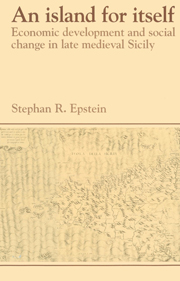Book contents
- Frontmatter
- Contents
- List of maps
- List of tables
- Acknowledgments
- Abbreviations
- Currency and measurements
- Chronology
- 1 Introduction. The historiography and the sources
- 2 Regional geographic and demographic differentiation
- 3 Market structures and regional specialization
- 4 Sicily and its regions. Economic growth and specialization
- 5 Sicily and its regions. Eastern val Demone and the southern mainland
- 6 Foreign trade and the domestic economy
- 7 Income distribution, social conflict and the Sicilian state
- 8 A further question: the origins of Sicilian underdevelopment
- Bibliography
- Index
- Past and Present Publications
5 - Sicily and its regions. Eastern val Demone and the southern mainland
Published online by Cambridge University Press: 06 January 2010
- Frontmatter
- Contents
- List of maps
- List of tables
- Acknowledgments
- Abbreviations
- Currency and measurements
- Chronology
- 1 Introduction. The historiography and the sources
- 2 Regional geographic and demographic differentiation
- 3 Market structures and regional specialization
- 4 Sicily and its regions. Economic growth and specialization
- 5 Sicily and its regions. Eastern val Demone and the southern mainland
- 6 Foreign trade and the domestic economy
- 7 Income distribution, social conflict and the Sicilian state
- 8 A further question: the origins of Sicilian underdevelopment
- Bibliography
- Index
- Past and Present Publications
Summary
In the previous chapters I have often referred to some unusual features of north-eastern Sicily (val Demone), and of its de facto capital (Messina). I have shown that despite possessing the harshest environmental features of Sicily's three valli, val Demone consistently maintained the highest population density in the region, and I have connected this fact with the area's high degree of agricultural and manufacturing specialization. I have also suggested that Messina's status as a city was largely a function of its role as Sicily's foremost gateway to the mainland.
In this chapter I examine these two features in more detail. In the first part of the chapter I look at Messina itself, at the origins of its fortunes in trade, and at its cycles of economic expansion and contraction. The development of Messina is of interest for my more general arguments, for it epitomizes the strengths and weaknesses of purely politico-institutional explanations of economic change. As noted in chapter 1, Benedetto Croce, followed by other historians, argued that the political separation caused by the Vespers of 1282 had disastrous economic effects because it severed all ties between Sicily and the mainland for more than a century and a half.1 If Messina's fortunes depended largely on trade across the Straits, as I suggest, the city should have suffered a disastrous decline as a result of the Siculo-Angevin war.
- Type
- Chapter
- Information
- An Island for ItselfEconomic Development and Social Change in Late Medieval Sicily, pp. 240 - 267Publisher: Cambridge University PressPrint publication year: 1992



